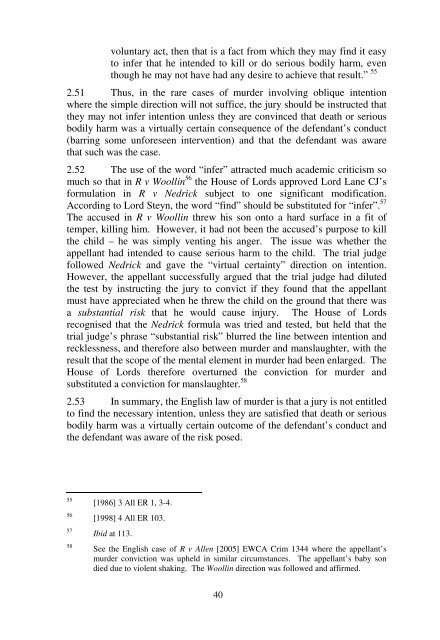murder and involuntary manslaughter - Law Reform Commission
murder and involuntary manslaughter - Law Reform Commission
murder and involuntary manslaughter - Law Reform Commission
You also want an ePaper? Increase the reach of your titles
YUMPU automatically turns print PDFs into web optimized ePapers that Google loves.
voluntary act, then that is a fact from which they may find it easyto infer that he intended to kill or do serious bodily harm, eventhough he may not have had any desire to achieve that result.” 552.51 Thus, in the rare cases of <strong>murder</strong> involving oblique intentionwhere the simple direction will not suffice, the jury should be instructed thatthey may not infer intention unless they are convinced that death or seriousbodily harm was a virtually certain consequence of the defendant’s conduct(barring some unforeseen intervention) <strong>and</strong> that the defendant was awarethat such was the case.2.52 The use of the word “infer” attracted much academic criticism somuch so that in R v Woollin 56 the House of Lords approved Lord Lane CJ’sformulation in R v Nedrick subject to one significant modification.According to Lord Steyn, the word “find” should be substituted for “infer”. 57The accused in R v Woollin threw his son onto a hard surface in a fit oftemper, killing him. However, it had not been the accused’s purpose to killthe child – he was simply venting his anger. The issue was whether theappellant had intended to cause serious harm to the child. The trial judgefollowed Nedrick <strong>and</strong> gave the “virtual certainty” direction on intention.However, the appellant successfully argued that the trial judge had dilutedthe test by instructing the jury to convict if they found that the appellantmust have appreciated when he threw the child on the ground that there wasa substantial risk that he would cause injury. The House of Lordsrecognised that the Nedrick formula was tried <strong>and</strong> tested, but held that thetrial judge’s phrase “substantial risk” blurred the line between intention <strong>and</strong>recklessness, <strong>and</strong> therefore also between <strong>murder</strong> <strong>and</strong> <strong>manslaughter</strong>, with theresult that the scope of the mental element in <strong>murder</strong> had been enlarged. TheHouse of Lords therefore overturned the conviction for <strong>murder</strong> <strong>and</strong>substituted a conviction for <strong>manslaughter</strong>. 582.53 In summary, the English law of <strong>murder</strong> is that a jury is not entitledto find the necessary intention, unless they are satisfied that death or seriousbodily harm was a virtually certain outcome of the defendant’s conduct <strong>and</strong>the defendant was aware of the risk posed.55565758[1986] 3 All ER 1, 3-4.[1998] 4 All ER 103.Ibid at 113.See the English case of R v Allen [2005] EWCA Crim 1344 where the appellant’s<strong>murder</strong> conviction was upheld in similar circumstances. The appellant’s baby sondied due to violent shaking. The Woollin direction was followed <strong>and</strong> affirmed.40
















